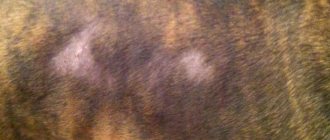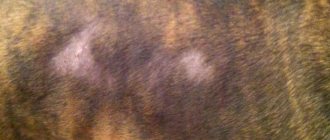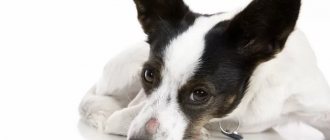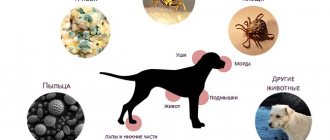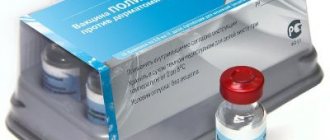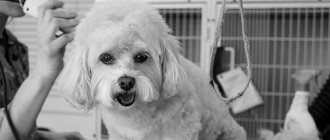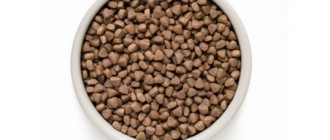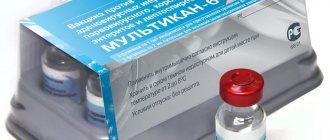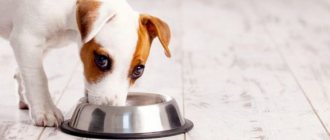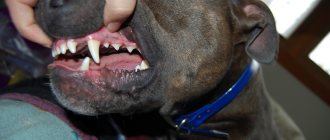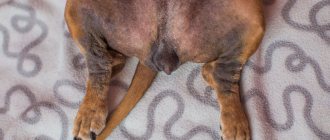Ringworm in dogs is a contagious skin disease that is difficult to treat and has a fungal or viral nature. If your pet suddenly begins to lose hair and strange red spots appear on its body, this is an alarm bell. It is possible that the dog has lichen, from which the animal may die if treatment is not started in time. What to do if you notice baldness and spots? How to quickly and effectively overcome an infection? How serious is it and can humans and other pets become infected from a dog? We will answer all these and other questions in our article.
What kind of disease is this
Ringworm is a group of skin diseases that have a similar clinical picture: rash, itching, inflammation and hair loss. Each type of pathology is caused by its own pathogen (fungi or virus), has its own causes, degree of infectiousness and methods of treatment.
Types of pathology
- Shingles (viral herpes). Viral skin disease. The causative agent is the herpes virus (Herpes zoster). The main places of localization are the abdomen and chest. The skin in the affected area is very itchy and painful. Dogs seek relief from suffering and itching and scratch the sore areas, introducing dirt and secondary infection into the wounds.
- Pityriasis versicolor (varicolored) does not cause suffering to pets. Visually, it looks like a small spot with a yellow, dried crust on a dog’s skin. The causative agent of the disease is yeast-like fungi. Over time, the crust changes color to brown. Most often, the paws and back of the dog are affected; it can be located on the animal’s neck.
- Ringworm is a non-contagious pathology. It develops as a consequence of allergic reactions to food. It can signal a sharp decrease in the dog’s immunity, and can also be a reaction to stressful situations. The second name of the pathology is weeping dermatitis. This type of lichen can become chronic. Visually it looks like bubbles on the skin filled with cloudy liquid. Over time, the bubbles burst and the liquid flows out. In the advanced stage, purulent mucus is released instead of fluid. Characterized by tissue swelling. The incubation period is 3-4 days.
- Ringworm (ring-shaped) is a contagious type of pathology. The infection is caused by the massive proliferation of two types of fungi: Microsporum and Trichophyton. Hair loss appears. The fur falls out in the form of oval spots, the area of which increases over time. If the proliferation of fungi is not stopped, lichen can cover the entire surface of the skin. Bald areas are very itchy. Itching irritates the animal and depresses its psyche. Dogs constantly scratch themselves, bringing dirt into the wounds. A fatal outcome cannot be ruled out. The incubation period of the disease is 3-12 days.
- Pityriasis rosea is not transmitted from dog to person. It differs from other types in that sick dogs do not experience severe discomfort with it. It looks like a small pink spot (1-3 cm). This pathology is considered an allergic reaction to viral infections. It affects dogs with weakened immune systems.
Important!
The incubation period for rosacea, herpes zoster and pityriasis versicolor is unknown.
Who is at risk
A healthy and strong immune system of a dog’s body is able to cope with the causative agents of lichen. But as soon as the animal’s immune system malfunctions, the risk of infection increases tenfold.
The risk group includes:
- puppies (up to 12 months), especially weakened and unvaccinated ones;
- dogs on an unsupervised walk;
- emaciated animals;
- pets who have had contact with stray animals;
- dogs during illness and recovery from serious illnesses;
- pets during the postoperative period;
- dogs with reduced immunity.
Routes of infection
Lichen spores can live in the external environment for several years. In addition, they are resistant to aggressive environments and some disinfectants. Therefore, the danger of fungal infection can lie in wait for a dog anywhere.
Main routes of infection:
- contact – from a sick animal (cat or dog);
- while walking – soil and plants can be inseminated with spores;
- through care items (combs);
- a person can bring fungal spores into the house on shoes or clothing.
Routes of infection
Let's look at the main causes of the disease in detail.
Upon contact with an infected animal. Fungi are especially common among outdoor dogs, which your pet may come into contact with while walking. It happens that pets also suffer from lichen, and the owners, hiding it, take them outside as usual.
Insignificant contact is enough for infection, so not only dogs are dangerous, but also other animals: cats, rodents, etc.
- With indirect contact. Infection can occur through contact not with an object that is a carrier of a fungal infection, but through objects - beds, toys, bowls, collars. Because of this, it is especially important to maintain good hygiene by providing your pet with personal items that are important for life.
- Through the environment. Pathogenic microorganisms that provoke the development of ringworm are highly resistant and can survive in difficult conditions. Therefore, their spores are stored for a long time in sand and soil, becoming a source of infection.
Ringworm is a disease that affects the body with a low level of immunity. When the body's defenses are in good condition, they are able to resist attacks from fungal diseases. In this case, no route of infection will be effective.
Most often, infection occurs in the cold season, autumn, winter, when many animals experience vitamin deficiency and decreased immunity.
Symptoms of lichen in a dog
Each type of lichen has its own symptoms. It is important to be attentive to your dog in order to notice warning signs in time and begin therapy.
General symptoms common to all species
- changes in taste preferences, dogs beg for sweets;
- apathy;
- sleep disorders;
- excitability;
- hyperthermia (except for herpes zoster);
- pale mucous membranes.
Symptoms of herpes zoster
- the appearance of large hairless areas on the neck, muzzle, back of the head and in the ear area;
- within a day, the spots swell and become inflamed;
- after a few days, the bald areas begin to itch and peel;
- If a dog scratches its receding hairline, secondary infection occurs, possibly suppuration and tissue necrosis.
Symptoms of pityriasis versicolor
- hyperthermia;
- large bald patches all over the dog’s body;
- the skin of bald areas changes color to bright pink or brown;
- peeling of the skin;
- Over time, bald patches begin to become wet and inflamed.
Symptoms of weeping lichen
- the appearance of large hairless spots in the tail or head area;
- severe itching, the dog itches;
- ichor oozes from the wounds;
- Over time, the wounds begin to bleed.
Ringworm - symptoms
- the appearance of “bald” oval-shaped areas throughout the animal’s body;
- severe itching;
- scratching the affected areas;
- Without treatment, bald patches begin to become wet and increase in area.
Pityriasis rosea - symptoms
- numerous hairless areas on the dog’s body, resembling a rash (size no more than 2 cm);
- redness of the affected areas;
- in the center of the spots the skin is yellow and peels;
- without treatment, the area of the spots increases, peeling and itching intensify.
Locations
Most often, lichen is localized in the head and neck area, on the limbs and around the tail of the dog. Typically, the first lesions appear on the animal's face and ears.
If proper treatment is not started in a timely manner, the pet will scratch itself, and the area of affected skin will gradually increase.
Advanced stage
At an advanced stage of the disease, with a long course, dermatophyte fungi often infect the claws of animals. They become thinner, become dull, lumpy, and begin to flake and break. As a rule, one or more claws of an animal are affected, and in most cases these lesions are asymmetrical - only on one paw or on different limbs. The most common cause of claw damage is fungi of the genus Trichophyton.
When hair follicles are affected by spores, folliculitis will most often be clinically observed, which also develops with demodicosis and pyoderma in dogs.
When spores of dermatophyte fungi enter the deep layers of the skin in dogs, a round, dense formation, a kerion, can develop at the sites of their penetration. Most often, kerion can be found in dogs on the limbs and face.
With the development of a generalized form of lichen, one can observe lesions similar in course to dry or oily seborrhea, in which the hair becomes oily, sticky, or, conversely, dry and brittle. Dogs are less likely to develop a generalized form of lichen than cats.
According to statistics, lichen infection is more common among dogs of long-haired breeds than among short-haired ones. There is also a breed predisposition to infection with dermatophytosis in medium and small terriers. But dogs of any breed and age can get lichen.
Diagnosis of the disease
If you experience one or more symptoms that indicate your dog may have shingles, you should contact your veterinarian immediately. Only in a clinical setting can a diagnosis be confirmed or refuted.
Diagnostic measures:
- Initial examination. The doctor examines the dog and studies the symptoms.
- Wood's lamp diagnostics. Examination of the animal under a “black light” (Wood’s lamp). Fungi and some other microorganisms emit a fluorescent glow under this light source.
- Sowing a fungal culture. This study is necessary to make a final diagnosis. It is considered the most reliable. A scraping is taken from diseased areas of the animal's skin and placed in a special environment where lichen spores begin to actively grow.
What does ringworm look like in dogs?
near the ear
on the head
on the stomach
on the paw
Photo - what lichen looks like in a dog
Main symptoms of the disease
Once a pet becomes infected, the disease may not be recognized immediately. He will make himself known only within a few days. Sometimes it may take a whole month. Veterinarians say that this is due to how strong the immune system is and the characteristics of the body.
A danger signal is the covering of areas of skin with a red rash. Therefore, it will not be difficult to find out what ringworm looks like in dogs. It will make itself felt with severe itching. Over time, a crust will appear on the spots. An untimely treated disease will lead to pus underneath.
The dog owner should visually inspect the most vulnerable areas of the skin - the head, ears and base of the tail. Inflamed colored spots appear on the animal's skin. They constantly bother the animal, as they exfoliate excessively. The advanced disease instantly spreads to the back, paws and stomach.
It will not be difficult to distinguish healthy hair from damaged hair upon examination. Diseased areas of the body make themselves known in the palest color. Doctors advise destroying the cut hair from the animal. It is better to separate the crusts that appear. A characteristic sign of the disease is the pet molting. Doctors warn owners that there is also an atypical form of development of the disease. There are no obvious signs. In this case, areas of baldness almost always appear.
If you carefully monitor the animal's condition, you can notice a change in behavior. The dog will constantly itch in one place and food intake will sharply decrease. The dog also becomes lethargic and inactive. When the first symptoms appear, you should immediately consult a doctor. Otherwise, the inevitable consequences will be hair loss and a decrease in the defenses of the immune system. It should be remembered that damage to the hair follicles causes complete baldness of the animal.
How to prevent ringworm in dogs
Veterinarians, when asked by owners about the treatment of ringworm in dogs, advise correct prevention. Daily wet cleaning is considered effective measures. To do this, you need to use disinfectants.
Until the final results of the examination are received and the course of treatment is completed, it is ideally advisable to isolate the animal. If this is not possible, then it is recommended to strictly adhere to preventive measures. It is necessary to vacuum fleecy floor coverings and upholstered furniture more often. Surfaces that your pet comes into contact with must be wiped with an aqueous solution containing bleach.
Since the fungus is very tenacious, it is recommended to wash all fabric coverings thoroughly and, if possible, boil them. Disinfecting cleaning is carried out throughout the premises. The animal's bedding is changed daily and processed. Avoid contact of a sick animal with small children. A sick animal should not be allowed to lie on the bed or upholstered furniture. It is necessary to change clothes yourself more often to avoid the spread of spores.
If the dog is sick, then after his recovery you need to dispose of the items he used. It is better to treat the place where it was located with 0.5% sodium hypochlorite. Experienced dog breeders walk their dogs exclusively among healthy dog breeders. This reduces the risk of contracting mycosis several times.
During treatment, you can resort to special shampoos. Bathing is carried out up to five times with an interval of 24-48 hours. It is necessary to carefully rinse off the foam so that it does not get into the dog’s stomach. If the dog has luxurious fur, it is recommended to shave it completely. If you have to do treatment in winter, then when walking a sick pet, you should wear overalls. Freezing can lead to decreased immunity.
It is necessary to bathe the dog. After returning from a walk, you need to wash your paws. The dog owner should periodically treat the dog's coat against parasites. During a walk, the animal should not come into contact with stray dogs.
An annual anti-infective vaccination against dermatomycosis is indicated. Vaccination is carried out in 2 doses. In this case, an interval of 10 days is observed. Immunity develops after 30 days. It has been proven that 90% of dogs do not get sick after vaccination. 10% experience the disease in a mild form. An examination by a veterinarian must be done once every six months.
Tips and tricks
- It is necessary that the animal’s food contains vegetables and fruits, whole grain cereals;
- Twice a week your pet should be offered dairy products (kefir, milk, cottage cheese);
- The meat must be cooked. In its raw form, it can cause worms;
- You must eat according to the set time;
- Veterinarians advise hardening your pet. Walk outside regularly in any weather. A walk does not have to be limited to a few minutes;
- Veterinarians recommend conducting a course of treatment with Altai mumiyo twice a year in order to increase the animal’s defenses.
When caring for a sick animal, precautions must be taken. All cleaning should be done with rubber gloves. It is necessary to take immunomodulators yourself, since fungal spores can also affect people, especially those with weak immune systems.
Keep in mind that trichophytosis can be caused by infestation with parasites (lice, worms), poor nutrition and severe psychological stress. A weakened body will not be able to resist the effects of the fungus. Proper nutrition is the key to immunity.
Currently reading:
- Thyroid dysfunction in dogs (hypothyroidism)
- Seven Signs and Remedies for Getting Rid of Fleas in Dogs
- How to recognize signs of dog poisoning from rat poisons
- Is it worth it or not to include natural food in your dog’s diet?
Treatment at home - traditional methods
We present traditional medicine recipes for your reference and remind you that all of them do not have proven effectiveness. In addition, uncontrolled use of these products without the advice of a veterinarian can harm your pet. Be careful and attentive!
First method
What you will need:
- disposable medical gloves;
- laundry soap;
- cotton pads;
- iodine.
How to process:
- put on gloves and carefully trim the hair in areas affected by lichen;
- Make a saturated soap solution from laundry soap and warm water;
- treat sore areas with cotton pads, being careful not to hurt the dog;
- After this, treat the affected areas with iodine.
The procedure is repeated daily until the animal recovers. To prevent your dog from licking its wounds, use an Elizabethan collar.
Important!
Remember that iodine is toxic to animals, do not overuse self-medication!
Second method
What you will need:
- disposable medical gloves;
- cotton pads;
- Apple vinegar.
How to process:
- put on disposable gloves and trim the hair around the wounds;
- soak a cotton pad in apple cider vinegar and treat the affected areas;
- repeat the treatment daily until the shingles go away.
This method is only suitable for pityriasis rosea. Other types of pathology are not treated in this way.
Important!
If traditional medicine does not help, be sure to show your pet to a veterinarian, he will tell you how to treat lichen in dogs.
Video
How to apply ointment correctly
The better prepared the affected area of a dog's skin for lichen, the greater the effect that can be achieved from the medicinal ointment, so every owner should know the algorithm of actions when treating an infectious source.
- Prepare the following items in advance: medical rubber gloves, blunt-tipped scissors, a metal container and matches, soap solution, antiseptic (furacilin, chlorhexidine, hydrogen peroxide), tweezers, gauze wipes, medicinal ointment.
- Before proceeding directly to the procedure, put on gloves.
- The affected area of skin is treated with an antiseptic solution.
- If there is hair along the periphery of the lesion, the hair is carefully cut at a distance of approximately 5 mm from the affected epidermis. The cut hair is immediately burned.
- If there are scabs, soak them in a soap solution until completely softened.
- The scabs are removed with tweezers, and the area is again treated with an antiseptic.
- Use a napkin to remove any remaining moisture.
- Apply ointment.
Upon completion of treatment of all affected areas, the clipped wool and napkins should be burned.
Professional treatment
The disease requires an integrated approach to treatment. The full course lasts from 6 to 8 weeks. This is due to the high survivability of fungal spores. It is impossible to completely cure a dog if you use only local treatment of the affected areas. To increase efficiency, treatment measures are carried out simultaneously with disinfection of the animal’s habitat and care items.
initial stage
While the area of the affected areas of the dog’s skin is not very large, it is enough to treat the affected areas with external antifungal and anti-inflammatory agents:
- creams;
- emulsions;
- ointments;
- sprays;
- shampoos.
Read more about popular external medications further in our article.
Severe (advanced) stage
In case of a large degree of damage and an advanced form of the pathology, it is necessary to give oral medications simultaneously with the treatment of diseased areas of the skin.
The most effective are:
- griseofulvin;
- ketoconazole;
- fluconazole;
- terbinafine;
- intraconazole
All these drugs are also used to treat humans. The veterinarian must select the product and calculate the permissible dosage.
Important!
Simultaneously with the treatment procedures, everything that the sick dog has come into contact with is disinfected.
External preparations – solutions, ointments, sprays
Ointment Yam Bk
A popular external fungicidal-bactericidal agent that has no analogues. It is highly effective against fungal diseases. It has been used in veterinary medicine for a long time. The product is low-toxic and safe for animals of all ages and conditions.
Contains: tar, salicylic acid, sulfur, turpentine, petroleum jelly, zinc oxide, creolin, lanolin.
How to use: apply a thin layer to the affected areas and around them (3-4 cm) with a special spatula 2-3 times a day for 7-10 days.
What it treats: ringworm, shingles.
Price: 20 mg pack. – 75 rub./18 UAH.
Fungin
A dermatological agent with an antifungal effect is available in the form of sprays and solutions. The main active ingredient is clotrimazole. The drug relieves the animal from itching and effectively destroys pathogenic cells. Has wound healing properties.
Contains: sulfur, glycerin, propolis.
How to use: the product is applied to and around the affected areas using a cotton swab or sterile gauze and gently rubbed into the skin. The procedure is repeated once a day for 10-14 days.
What it treats: ringworm, pityriasis versicolor.
Price: solution (30 ml.) – 310 rub./85 UAH; spray (30 ml.) – 415 RUR/115 UAH.
Clotrimazole
The antifungal agent is based on synthetic imidazole. The active component suppresses the proliferation of the fungus and causes its death.
How to use: Apply a thin layer of ointment to the affected areas of the skin, covering the area around them. The procedure is repeated 3-4 times a day for 3-4 weeks.
What it treats: pityriasis versicolor.
Price: tube (20 g.) – 185 rub./31 UAH.
Sanoderm
Complex action cream based on betamethasone, gentamicin and clotrimazole. It has antibacterial, anti-inflammatory and anti-allergenic effects. Effective against fungi.
How to use: apply a thin layer to affected areas 2 times a day for 2-4 weeks.
What it treats: ringworm.
Price: tube (15 g.) – 110 rub./55 UAH.
Fukortsin
The solution, popularly called “red brilliant green,” has an antiseptic and disinfectant effect. Contains: boric acid, phenol, acetone and resorcinol. The product is toxic and should not be licked off.
How to use: the affected areas are lubricated with the solution 3 times a day until complete healing.
What it treats: shingles, ringworm.
Price: bottle (25 ml.) – 40 rub./10 UAH.
Imaverol
An effective antifungal emulsion based on enilconazole. The active substance destroys fungal spores at the cellular level. Used in complex therapy. The product is safe, acts in the superficial layers of the skin, and is quickly removed.
How to use: before use, dilute the emulsion with boiled water at room temperature (1:50). The affected areas of the skin are treated with a cotton pad once every 4 days.
What it treats: ringworm.
Price: bottle (100 ml.) – 1450 rub./845 UAH.
Oral medications – capsules, tablets
Griseofulvin
Antifungal antibiotic based on the substance Griseofulvin. Has a cumulative effect. The active ingredient of the drug stops the proliferation of the fungus.
How to use: Give dogs 1 tablet 4 times a day during feeding. The course of treatment is 14-20 days.
What it treats: ringworm.
Price: pack (20 tablets) – 220 rub./45 UAH.
Ketoconazole
Tablets with antifungal, fungistatic and antiandrogenic effects. The drug is considered potent.
How to use: give to animals with food at a dosage of 5-10 mg/kg every 10-12 hours or once a day at a rate of 10-20 mg/kg.
What it treats: ringworm, weeping lichen.
Price: packaging (10 tablets) – 150 rub./130 UAH.
Fluconazole
A synthetic antifungal agent inhibits the activity of fungi. It is excreted unchanged through the dog's kidneys.
How to use: give to animals along with food at a dosage of 10-20 mg/kg 2 times a day.
What it treats: ringworm, weeping, pityriasis versicolor.
Price: packaging (10 tablets) – 35 rub./12 UAH.
Terbinafine
Tablets with pronounced antimycotic and anti-inflammatory effects are prescribed as part of complex therapy. Shows activity against pathogens of dermatomycosis.
How to use: give to animals with food once a day at a dosage of 20-30 mg/kg.
What it treats: pityriasis versicolor (lichen versicolor).
Price: pack (10 tablets) – 140 rub./45 UAH.
Intraconazole
The most effective medicine in the treatment of ringworm. Itraconazole suppresses the proliferation of the fungus and prevents it from developing. Available in capsule form.
How to use: give to animals with food once a day at a dosage of 10 mg/kg. The course of treatment is up to 1 month.
What it treats: ringworm.
Price: pack (14 drops) – 320 rub./43 UAH.
Therapeutic vaccines
The most effective in the treatment of lichen are therapeutic and prophylactic vaccines. For medicinal purposes, injections are given 2-3 times with an interval of 10-14 days.
The following drugs are used to vaccinate dogs:
- Polivac TM;
- Vakderm-F;
- Microderm.
How to know if treatment is helping
Signs indicating that therapy is effective:
- In the affected areas, crusts are actively separated.
- New fur begins to grow on the bald patches.
- Skin redness disappears.
- The itching goes away and the dog itches less.
It is possible to finally ensure that the treatment has achieved its goal only in a clinical setting. There, the dog is examined under a Wood's lamp and scrapings and cultures are taken. Only after two negative tests performed at monthly intervals can we talk about the dog’s complete healing.
What can you do to speed up your recovery?
How to cure a dog from lichen without causing complications? The main condition is strict adherence to the recommendations of the veterinarian. The animal must be given medications in strict accordance with the prescribed course and dosage, without skipping doses. Unauthorized replacement of one medicine with another, as well as termination of therapy prematurely, is not allowed. The dog owner should be prepared for the fact that in some cases treatment may take a month or more.
Treatment with special shampoos that contain antifungal components will help speed up the recovery of your four-legged friend and prevent the spread of infection. Such hair care products are gentle on the surface of the skin, but using them for a long time is not recommended. To avoid excessive dryness of the epidermis, follow the instructions.
Is ringworm in dogs dangerous to human health?
Pink and weeping lichen does not pose any danger to humans and other pets. We have already mentioned this in our article.
Ringworm, shingles and pityriasis versicolor are contagious diseases. It is not dangerous only for absolutely healthy people with strong immunity. If a person’s immune system copes with the disease on its own, one can become infected and not notice it.
But for young children, people with compromised immunity, pregnant and lactating women, lichen poses a huge danger . Therefore, you need to take precautions when interacting with animals.
The danger of infection is not only from stray street dogs and sick animals. You can also get infected from pets if they are carriers of fungal spores.
Prevention
Prevention measures:
- Preventive vaccination against lichen.
- Never touch unfamiliar dogs and cats. Prohibit children from approaching stray dogs and cats.
- Maintain good hygiene. Wash your hands with antibacterial soap after each contact with the dog and its accessories, and upon returning from the street.
- Clean the hallway regularly with disinfectants.
- After each walk, wash your animal's paws and your shoes.
- Try to prevent your dog from coming into contact with stray animals.
- Follow quarantine measures if there is a sick animal in the house.
Vaccination against ringworm
Therapeutic and prophylactic vaccines (Polivak TM, Vakderm-F, Microderm) are used both as part of therapy and for prevention.
How is vaccination carried out:
- 10-14 days before vaccination, the animal is treated with anti-parasitics;
- the first vaccine is administered at the age of 2-3 months;
- after 10-14 days the procedure is repeated;
- the first 3-5 days after vaccination the dog is freed from physical activity;
- revaccination is carried out after 1 year.
Proper nutrition for your pet during treatment
In order for the body to have the strength to fight and help the medications work, you need to feed your pet properly. You definitely need to add vitamins to your diet.
The body takes everything valuable from the diet; if the dog gets sick, the menu is reviewed. Dry food is temporarily replaced with a medicinal variety, and an immunostimulating powder is added to natural food. The table should consist of a sufficient amount of proteins - this way the wounds will heal even faster.
More care is added to proper nutrition. Wounds are regularly treated and smeared with ointment.
Another side of care is the thorough cleaning of a house or apartment. Everything must be cleaned daily using disinfectants. Pet toys are washed thoroughly and regularly. Direct contact with other family members and other animals is excluded.
Dog Owner Stories
Valeria: “My shepherd dog developed some kind of black crust on his nose, then the hair in this area began to fall out. The vet diagnosed it as ringworm. We were prescribed Imaverol. They told me to treat the affected area of the nose once every 3-4 days for 2 months. They also prescribed Clotrimazole ointment to smear my nose with. Additionally, they advised to give the dog vitamins. After the first treatment with Imaverol, the dog’s nose turned red and there was ichor in some places. It scared us. But, after 3 days everything began to dry out, and a week later new hairs of fur began to appear on the nose. We managed to completely get rid of lichen in 1.5 months.”
Sergey: “My Yorkie got shingles after the show. We received 2 Microderm injections. One was done immediately at the appointment, the second was done 10 days later. During breaks, I treated the affected areas with Yam ointment. We got rid of this infection quite quickly. During the treatment period, we went with the dog to live in the country so as not to infect the children and the cat.”
Marina: “I always thought that only cats have lichen. Therefore, I didn’t pay much attention when my dog’s hair began to fall out around his eye and redness appeared. The first days I lubricated this area with iodine. It seemed to me that this would be right. But when, after a week, the spot began to increase in size, and the dog began to try to scratch the eye, I got scared. My husband and I took her to the vet. Only there I found out that it was lichen. The doctor immediately prescribed Itraconazole tablets and forbade me to smear the area with iodine. Instead of iodine, he advised treating the wound with Fukortsin. We were treated for almost 2 months. If I had known earlier how dogs get lichen, we would have cured the dog faster.”
The first signs of lichen
Knowing how the manifestation of ringworm begins, you can diagnose the infection in time. At least two weeks pass from infection to the appearance of the first signs of the fungus, during which time the lichen practically does not appear. This is especially difficult when long-haired breeds are infected, whose skin is not visible behind the hair.
The fungus penetrates the hair follicle, this happens gradually. Redness appears, accompanied by itching. The dog has a natural desire to scratch this area, so the initial stage is determined by scabies. At the site of redness, a bump and a slight swelling appear. However, other types of skin diseases also have this form of manifestation.
Then the affected areas become noticeable: spots appear in the foci of inflammation that have a clear outline, as if outlined. The skin peels off and the crusts fall off. These signs of lichen are easy to distinguish from other ailments.
